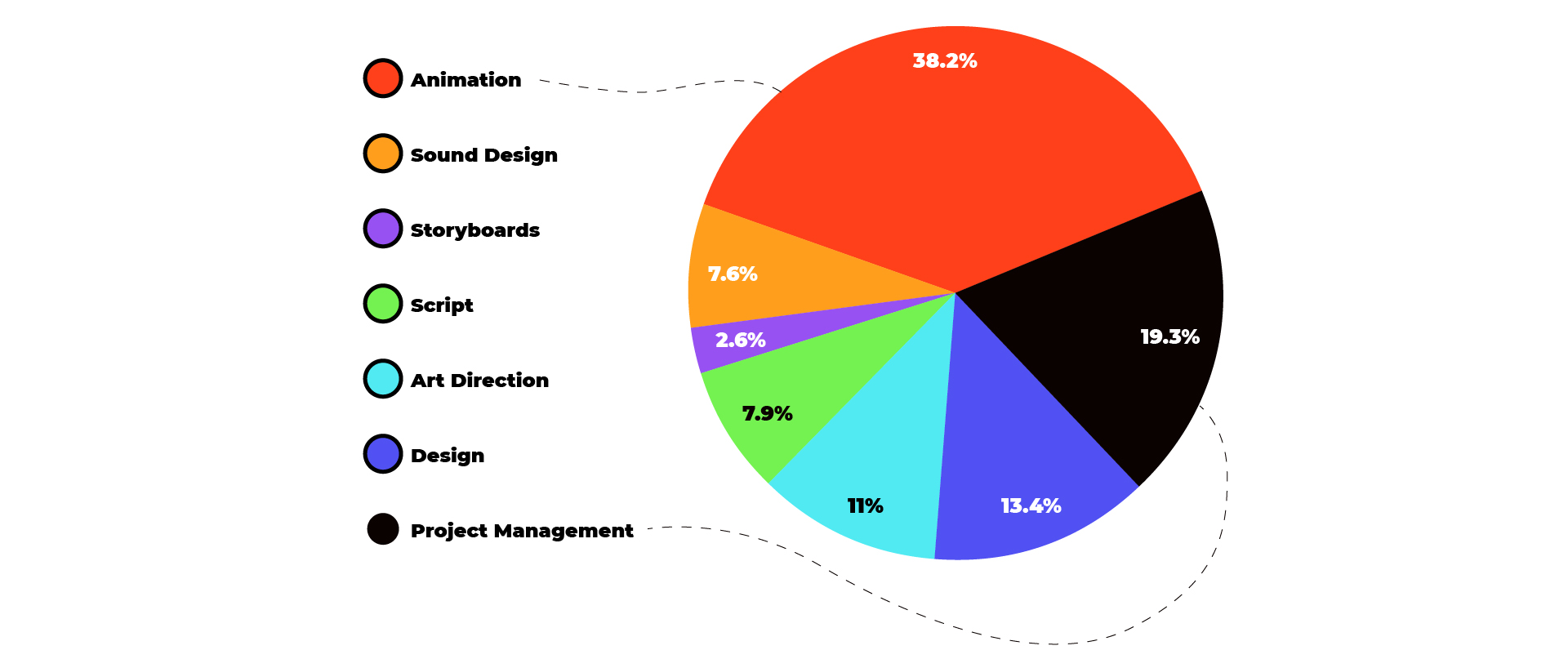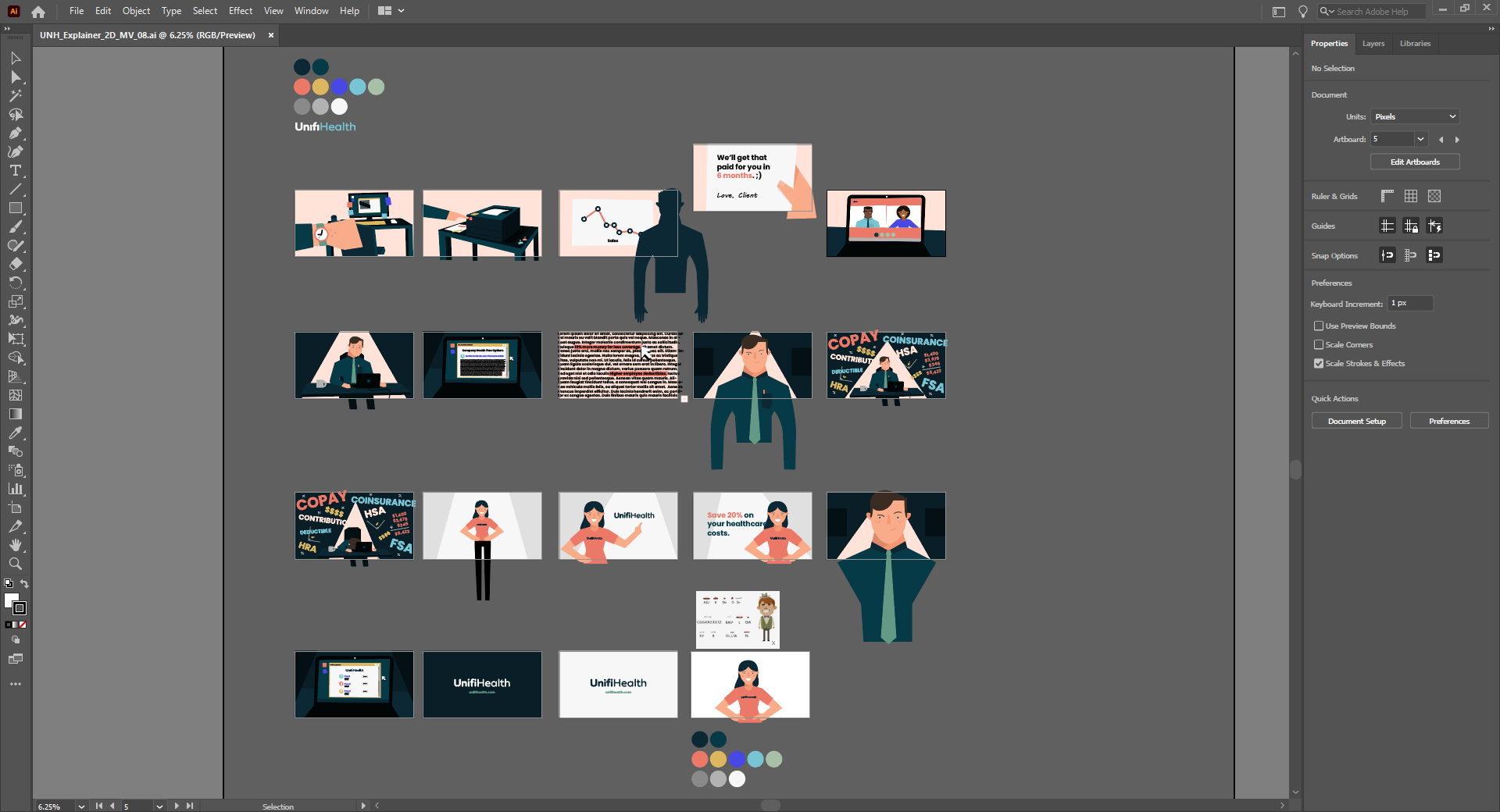So, what exactly goes into an animation project?
Typically, we’d answer that question very briefly. In this post though, I’m going to break down the details for you so you can get a full understanding of what it takes to create an animated project and where that time is spent.

Let’s start by taking a look at this pie chart with actual data from a recent project our team worked on. Here are some things to note about this chart for a frame of reference:
- The final deliverable was a 60-second animation that included 2D illustration and animation.
- The overall turnaround time on the project was about 4 weeks.
- The one element NOT included in this chart is discovery, which we complete outside of the production process.
- We had a team of 5 working on this particular project.
- These numbers can vary wildly depending on the project, but these specific numbers come from one of our “simpler” projects.
Ok, here we go!
“Ring! Ring!”
“Made By Things, thank god you’re there, we need you!”
Ok, so it’s not usually EXACTLY like that but sometimes it feels that way ;). We start each project with our discovery phase. It’s how we learn the scope of what needs to be produced so we can put together our expert recommendations on the type of content, length, style, and maybe even some additional content opportunities.
Once a decision is made, we jump into building a schedule and setting up a plan for the project. Our first step of production is project management. Every project we work on has a budget determined in the discovery process. With project management, we make sure the plan we’ve put forward helps us create great results within that budget. Creativity flourishes with guidelines and project management helps us do just that. Unlike the other stages of an animation project, Project Management goes on throughout the entire project and accounts for about 20% of the total time we spend working on a film. These are the people that communicate with our internal team and clients to make sure everyone is on the same page.
Once our plan is set, the next stop is the script (or story) we’re going to tell. This makes up about 8% of an animation project. This part of the process is very important to start with to make sure we’re communicating the right message for the brand before we even think about what the visuals will be.
Then we jump into art direction, also known as style frame development. This part of the process accounts for about 11% of an animation project. A crucial part of the project that helps determine how the project will look. Up till this point, most of what’s been discussed for visuals are just ideas, but here, we develop a few frames in different styles that would each work as a solution for the script, the brand, and the particular message of that video.

After client approval on an art direction, we develop the script out as a storyboard. These are usually pencil sketches of how we are imagining the film to play out. We often put some temporary music and voice-over in our video here with some subtle animation to give us our first look at the timing, scene layout, and overall feel of the video. We call this an “animatic”. This part of the process only accounts for about 2.6% of an overall project. Part of what makes this step so valuable is how little time it takes to start seeing the big picture.
Speaking of the big picture. After we get a great animatic together, we go back to our approved art direction and we keep pushing forward by designing ALL the frames to be in the final film. This could be graphic design, illustration, or building out 3D scenes. This part is about 13% of the total process.

As you’d expect, the part that takes the most time in an animation project… is animation. Oddly enough, it’s one of the final parts of an animation project. We take our designed scenes, update our animatic along the way and then create animation for each scene in our film. Depending on the style of the film, this part of the process can range from 40-60% of the total time spent on an animation project. Usually, 3D animation and hand-drawn animation take a bit longer to complete than a motion graphics piece would take. And also depending on any character animation, that might make that number even higher.
One part of the process not mentioned is the technical aspects of a project, especially a 3D project. That might include added parts of the process such as scene modeling, texturing, lighting, rigging, and rendering. All reasons why 3D projects can take a bit longer than 2D projects.
Finally, we take everything and apply sound design. We add the final music selection (or composed track), sound effects and mix it with a professionally recorded voice-over to create that beautiful multi-sensory experience for a viewer. This part of the process takes about 7.6% of the total process. Often seen as an afterthought by many studios, we LOVE this part of the process since it’s the cherry on top that really brings the illusion of life and story together into one magical experience.
There you have it, folks! Animation projects can be VERY complex, but understanding them at a high level can help you understand the decisions being made, the amount of work, and the breakdown of tasks on your next animation project.
If you’d like some help on your next animation project, head over to the “start a project” page and simply answer a few questions, hit submit and we’ll be in touch within a couple of days with the next steps!
